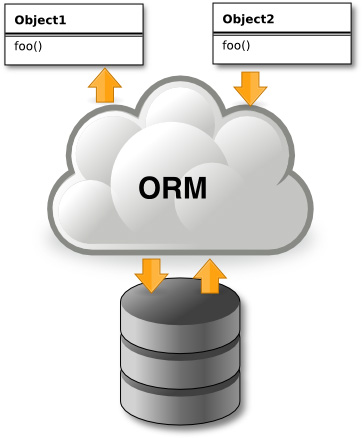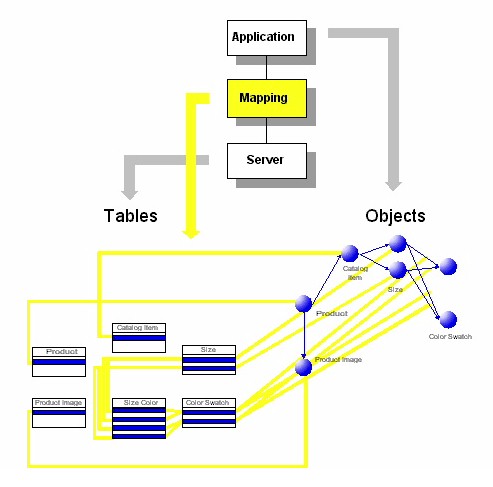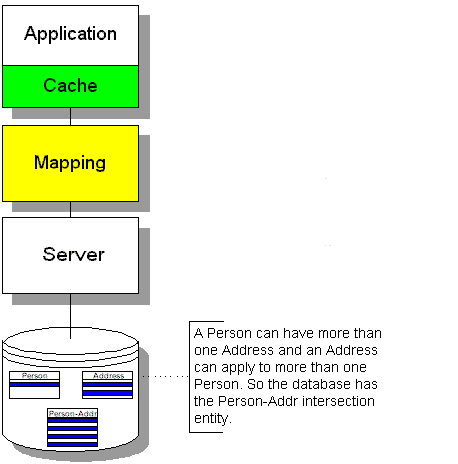CSC/ECE 517 Fall 2014/ch1a 25 jf
Object-relational Mapping
Object-relational Mapping (ORM, O/RM, and O/R mapping) in computer science is a programming technique for converting data between incompatible type systems in object-oriented programming languages. It creates a "virtual object database" that can be used from within the programming language. There are both free and commercial packages available that perform object-relational mapping, although some programmers choose to create their own ORM tools. Object code is written in object-oriented programming (OOP) languages such as Java, Ruby, C++ or C#. All in all, ORM is used to connect object code to a relational database and converts data between type systems that are unable to coexist within relational databases and OOP languages.<ref name=techopedia>Techopedia,Object-Relational Mapping</ref>
Background
In Object-oriented programming, data management tasks act on Object-oriented (OO) objects that are almost always non-scalar values. For example, consider an address book entry that represents a single person along with zero or more phone numbers and zero or more addresses. This could be modeled in an object-oriented implementation by a "Person object" with attributes/fields to hold each data item that the entry comprises: the person's name, a list of phone numbers, and a list of addresses. The list of phone numbers would itself contain "PhoneNumber objects" and so on. The address book entry is treated as a single object by the programming language ( It can be referenced by a single variable containing a pointer to the object, for instance). Various methods can be associated with the object, such as a method to return the preferred phone number and the home address.
However, many popular database products such as Structured Query Language(SQL), Database Management Systems (DBMS) can only store and manipulate scalar values such as integers and strings organized within tables. The programmer must either convert the object values into groups of simpler values for storage in the database (and convert them back upon retrieval), or only use simple scalar values within the program. Object-relational mapping is used to implement the first approach.
The core problem is translating the logical representation of the objects into an atomized form that is capable of being stored in the database, while preserving the properties of the objects and their relationships so that they can be reloaded as objects when needed. If this storage and retrieval functionality is implemented, the objects are said to be persistent.
ORM Architecture and Framework
Why to use ORM framework?
ORM framework were designed to reduce the amount of work, which needed to develop an object-oriented system that stores data in a relational database. The core problem is that the structure of in-memory objects does not match up well with the structure of data in relational databases. It is always a very slow and repetitive process to develop all the codes that is required to move the information between the object space and the relational space, but ORM framework can make these things easier.<ref name=Frameworks>introduction to ColdFusion frameworks</ref>

What goal does ORM framework want to accomplish?
The goal of a ORM framework is to automatically map objects to and from a database seamlessly so that information can be quickly and easily retrieved in the object format, and then subsequently stored in its relational structure. This can make things easier in the process of system development and maintenance. The details of writing your own create, read, update, and delete methods are automatically generated for you, so you can concentrate on designing and building for your application.
Consider a project in which the application configuration is working smoothly. Your Model, View, and Controller is separated wonderfully. So it is possible that you’re spending three quarters of your time writing boring SQL statements to put data in the database, take it out, and edit it. In practice, writing SQL and matching the data make developing your application really slow, and maintaining still needs to do numerous changes just for something simple, such as adding a column to a table.
In this case, if using a ORM framework, things will be far easier. It doesn't need to write the SQL statement to do create, read, update, and delete operations anymore — because it is automatically generated for you. Pulling information from the database is as simple as sending parameters to the framework. To update the data, it just needs to pass parameters back to the framework, which will manages it. Therefore, it can save lots of time to work on how the application is meant to function and how to design it, rather than the mundane details of pushing and pulling data from your database.
The below figure illustrates what occurs via using ORM framework in a project. The yellow lines show the details of mapping process. The mapping lines do not connect directly to the color swatch objects, it means that the join involving the "Size Color" table is creating the reference from the size objects to the color swatch objects.<ref>Service Architecture-Mapping Layer</ref>

What does an ORM framework do?
ORM framework generates objects that virtually map the tables in a database<ref name=framework>What are ORM Frameworks?, http://www.killerphp.com/articles/what-are-orm-frameworks/#sthash.xY8Xrpj9.dpuf</ref>. As a programmer, you would use these objects to interact with the database. So the main idea, is to try and shield the programmer from having to write optimized SQL code – the ORM generated objects take care of that for you. So let’s take a look at a simple example:
Say for instance you had a database with two tables:
- Clients
- Products
With a little bit of configuration on your part, the ORM framework would create corresponding objects (say, clients_object and products_object) that would handle all the database interaction. So let’s say you need to add a new client to the database, you would just have to use the ORM’s clients_object to add the new client. For example, it could be as simple as calling the object’s ‘save()’ method:
client = new clients_object("Stefan","Mischook");
client.save();
The above of code, is just pseudo code, mainly because the syntax will vary from ORM framework and from language to language. But hopefully you get the general idea of how much easier an ORM framework can make things.
In other words, instead of something like this:
String sql = "SELECT ... FROM persons WHERE id = 10" DbCommand cmd = new DbCommand(connection, sql); Result res = cmd.Execute(); String name = res[0]["FIRST_NAME"];
When to use an ORM framework?
From my personal experience, an ORM framework becomes more useful as the size and complexity of the project increases. If you just have a simple database with say 5 tables and 5-6 queries … setting up an ORM framework may be overkill. I would start considering the use of ORM when:
- You have 3 or more programmers on a web application.
- Your database consist of 10+ tables.
- You have say 10+ queries to make.
How does Object-Relational Mapping work?
<ref name=serviceArch>Service Architecture,Transparent Persistence in Object-Relational Mapping</ref> In object-relational mapping products, the ability to directly manipulate data stored in a relational database using an object programming language is called transparent persistence. This is in contrast to a database sub-language used by embedded SQL or a call interface used by ODBC or JDBC. See transparent persistence vs. JDBC call-level interface.
Using an object-relational mapping product means you will have less code to write and, depending on how you use your data, you might have higher performance over an embedded SQL or a call interface. See caching for object-relational mapping.
With transparent persistence, the manipulation and traversal of persistent objects is performed directly by the object programming language in the same manner as in-memory, non-persistent objects. This is achieved through the use of intelligent caching as this animation shows. For coding examples, see how to access data in a relational database.

Comparison with Traditional Methods
Compared to traditional techniques of exchange between an object-oriented language and a relational database, ORM often reduces the amount of code that needs to be written.<ref>Douglas Barry, Torsten Stanienda, "Solving the Java Object Storage Problem," Computer, vol. 31, no. 11, pp. 33-40, Nov. 1998, http://www2.computer.org/portal/web/csdl/doi/10.1109/2.730734, Excerpt at http://www.service-architecture.com/object-relational-mapping/articles/transparent_persistence_vs_jdbc_call-level_interface.html. Lines of code using O/R are only a fraction of those needed for a call-level interface (1:4). For this exercise, 496 lines of code were needed using the ODMG Java Binding compared to 1,923 lines of code using JDBC.</ref>
Disadvantages of O/R mapping tools generally stem from the high level of abstraction obscuring what is actually happening in the implementation code. Also, heavy reliance on ORM software has been cited as a major factor in producing poorly designed databases.<ref>Josh Berkus, "Wrecking Your Database", Computer, Aug. 2009, http://it.toolbox.com/blogs/database-soup/wrecking-your-database-33298, Webcast at http://www.youtube.com/watch?v=uFLRc6y_O3s</ref>
Simple Example with ORM
<ref name=sample>StackOverFlow,What is an Object-Relational Mapping Framework?</ref>
String sql = "SELECT ... FROM persons WHERE id = 10" DbCommand cmd = new DbCommand(connection, sql); Result res = cmd.Execute(); String name = res[0]["FIRST_NAME"];
you do something like this:
Person p = repository.GetPerson(10); String name = p.FirstName;
or similar code (lots of variations here.) Some frameworks also put a lot of the code in as static methods on the classes themselves, which means you could do something like this instead:
Person p = Person.Get(10);
Some also implement complex query systems, so you could do this:
Person p = Person.Get(Person.Properties.Id == 10);
See Detailed Sample in Java concerning Objected Relational Mapping at A standardized object-relational mapping mechanism for the Java platform
ORM Language and Main Tools
This table just includes several well-known object-relational mapping tools regarding to some popular programming languages. It is not up-to-date or all-inclusive. <ref name=listOfORM>Wikipedia,List of Object-relational mapping Software</ref>
| Name | C++ | .NET | Objective-C | Java | Python | Perl | PHP | Ruby |
|---|---|---|---|---|---|---|---|---|
| Several Object-Relational Mapping Tools | LiteSQL | ADO.NET Entity Framework | core Data | jOOQ | Django | DBIx::Class | CakePHP | ActiveRecord |
| ODB | Nhibernate | Enterprise Objects | Apache_Gora | Peewee ORM | Doctrine | Sequel
| ||
| Wt::Dbo | OpenAccess ORM | Hibernate ORM | SQLAlchemy | FuelPHP | DataMapper |
Comparison between ORM tools
The following table lists several well-known object-relational mapping tools <ref name=comparisonOfORM> Wikipedia, Comparison of Object-relational mapping Software</ref>
| ORM Tools | Platform | Availablity | Version |
|---|---|---|---|
| LiteSQL | C++ | Open Source | 0.3.15 / August 10, 2012 |
| ODB | C++ | Dual-licensed(GNU GPL/Proprietary License) | 2.3.0 / October 30, 2013 |
| Wt::Dbo | C++ | Dual-licensed(GNU GPL/Proprietary License) | 3.3.3 / May 27, 2014 |
| ADO.NET Entity Framework | .NET3.5(SP1)+ | Part of .NET 4.0 | EF5.0 |
| Nhibernate | .NET2.0(SP1)+ | Open Source | NH3.3.1 |
| OpenAccess ORM | .NET2.0+ | Free & Commercial | Version 2012.2.816.1 |
| core Data | Objective-C | Commercial | 3.2.0 |
| Enterprise Objects Framework | Objective-C | Commercial | WebObjects 5, released in 2001 |
| jOOQ | Java Virtual Machine | Dual-licensed(ASL 2.0/Commercial) | 3.3.0 / February 14, 2014 |
| Apache_Gora | Java Virtual Machine | Open Source | 0.4 / April 14, 2014 |
| Hibernate ORM | Java Virtual Machine | Open Source | 4.2.5 / August 28, 2013 |
| Django | Python | Open Source | 1.7 / September 2, 2014 |
| Peewee ORM | Python | Open Source | 2.2.3 / April 20, 2014 |
| SQLAlchemy | Python | Open Source | 0.9.4 / March 28, 2014 |
| DBIx::Class | Perl | Open Source | 0.08270 / January 31, 2014 |
| CakePHP | PHP | Open Source | 2.5.4 /September 2, 2014 |
| Doctrine | PHP | Open Source | 2.4/April 8, 2014 |
| FuelPHP | PHP | Open Source | 1.7.2/ July 13, 2014 |
| ActiveRecord | Ruby | Open Source | 4.2.0.beta1/ Aug 20, 2014 |
| Sequel | Ruby | Open Source | 4.14.0 / September 1, 2014 |
| DataMapper | Ruby | Open Source | 1.2.0/October 13, 2011 |
ORM Advantage and Disadvantage
Advantage
- Facilitates implementing the Domain Model pattern. This one reason supercedes all others. In short using this pattern means that you model entities based on real business concepts rather than based on your database structure. ORM tools provide this functionality through mapping between the logical business model and the physical storage model.
- Huge reduction in code. ORM tools provide a host of services thereby allowing developers to focus on the business logic of the application rather than repetitive CRUD (Create Read Update Delete) logic.
- Changes to the object model are made in one place. One you update your object definitions, the ORM will automatically use the updated structure for retrievals and updates. There are no SQL Update, Delete and Insert statements strewn throughout different layers of the application that need modification.
- Rich query capability. ORM tools provide an object oriented query language. This allows application developers to focus on the object model and not to have to be concerned with the database structure or SQL semantics. The ORM tool itself will translate the query language into the appropriate syntax for the database.
- Navigation. You can navigate object relationships transparently. Related objects are automatically loaded as needed. For example if you load a PO and you want to access it's Customer, you can simply access PO.Customer and the ORM will take care of loading the data for you without any effort on your part.
- Data loads are completely configurable allowing you to load the data appropriate for each scenario. For example in one scenario you might want to load a list of POs without any of it's child / related objects, while in other scenarious you can specify to load a PO, with all it's child LineItems, etc.
- Concurrency support. Support for multiple users updating the same data simultaneously.
- Cache managment. Entities are cached in memory thereby reducing load on the database.
- Transaction management and Isolation. All object changes occur scoped to a transaction. The entire transaction can either be committed or rolled back. Multiple transactions can be active in memory in the same time, and each transactions changes are isolated form on another.
- Key Management. Identifiers and surrogate keys are automatically propogated and managed.<ref>http://blogs.msdn.com/b/gblock/archive/2006/10/26/ten-advantages-of-an-orm.aspx</ref>
Disadvantage
Disadvantages regarding Enterprise Application Development.<ref name=disadvantage>StackOverFlow,Disadvantage for ORM in Enterprise Application Development</ref>
- Configuration: ORM technologies require configuration files to map table schemas into object structures. In large enterprise systems the configuration grows very quickly and becomes extremely difficult to create and manage. Maintaining the configuration also gets tedious and unmaintainable as business requirements and models constantly change and evolve in an agile environment.
- Custom Queries: The ability to map custom queries that do not fit into any defined object is either not supported or not recommended by the framework providers. Developers are forced to find work-arounds by writing ad hoc objects and queries, or writing custom code to get the data they need. They may have to use Stored Procedures on a regular basis for anything more complex than a simple Select.
- Proprietary binding: These frameworks require the use of proprietary libraries and proprietary object query languages that are not standardized in the computer science industry. These proprietary libraries and query languages bind the application to the specific implementation of the provider with little or no flexibility to change if required and no interoperability to collaborate with each other.
- Object Query Languages: New query languages called Object Query Languages are provided to perform queries on the object model. They automatically generate SQL queries against the database and the user is abstracted from the process. To Object Oriented developers this may seem like a benefit since they feel the problem of writing SQL is solved. The problem in practicality is that these query languages cannot support some of the intermediate to advanced SQL constructs required by most real world applications. They also prevent developers from tweaking the SQL queries if necessary.
- Performance: The ORM layers use reflection and introspection to instantiate and populate the objects with data from the database. These are costly operations in terms of processing and add to the performance degradation of the mapping operations. The Object Queries that are translated to produce unoptimized queries without the option of tuning them causing significant performance losses and overloading of the database management systems. Performance tuning the SQL is almost impossible since the frameworks provide little flexibility over controlling the SQL that gets auto generated.
- Tight coupling: This approach creates a tight dependency between model objects and database schemas. Developers don't want a one-to-one correlation between database fields and class fields. Changing the database schema has rippling affects in the object model and mapping configuration and vice versa.
- Caches: This approach also requires the use of object caches and contexts that are necessary to maintain and track the state of the object and reduce database roundtrips for the cached data. These caches if not maintained and synchronized in a multi-tiered implementation can have significant ramifications in terms of data-accuracy and concurrency. Often third party caches or external caches have to be plugged in to solve this problem, adding extensive burden to the data-access layer.
See Also
- Wikipedia, Object-relational Mapping
- Wikipedia, Object-oriented Programming
- Hibernate Overview,What is Object/Relational Mapping?
- Object-relational Mapping Overview
- Service Architecture, Object-Relational Mapping Articles
- Object-Relational Mapping Concepts
- Choosing an object-relational mapping tool by Fabrice Marguerie
- Mapping Objects to Relational Databases: O/R Mapping In Detail
- RailsGuides Active Record Basics
- Ruby on Rails official website
- Object-Relational Mapping
References
<references></references>